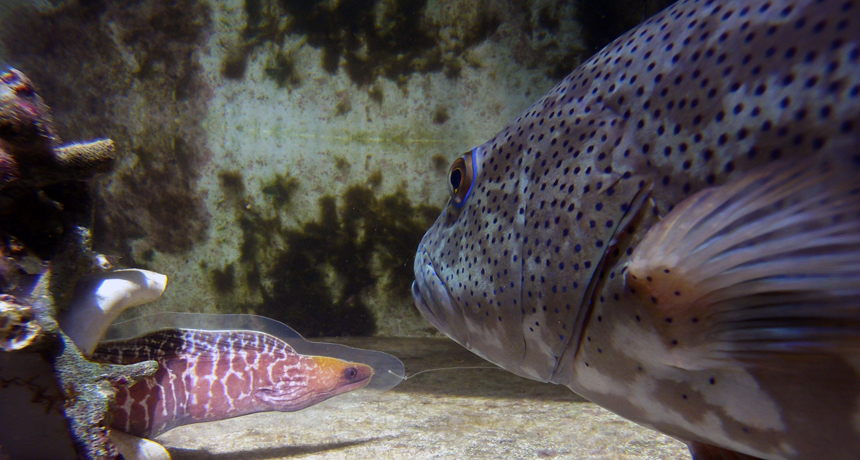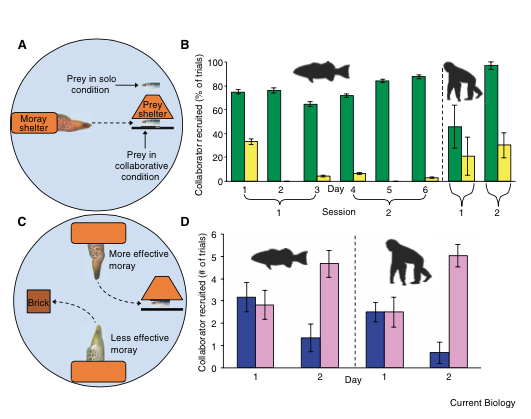Cooperative Hunting Behavior of Moray Eels and Groupers
Biology 342 Fall 2015
Clara Herrera & Hye Min Park
Ontogeny
Questions on the ontogeny of moray and grouper cooperative hunting ask:
Do fish have the capability to decide when and with whom to hunt?
Can fish learn to initiate more efficient methods of cooperative hunting?
Since the cooperative hunting behavior between giant moray eels and groupers has not been extensively studied, we will answer these questions using a similar coordinated hunting behavior between coral trout (Plectropomus leopardus) and giant moray eels.
Experiments:
Alex Vail and coworkers conducted experiments, which measured how frequently trout chose to collaborate with giant moray eels and whether they could distinguish between more and less effective moray eels when hunting.
Both experiments resulted in the animal who initiated hunting (the trout or the chimpanzee) developing a preference toward effective hunting partners after one day.

Figure 4. Picture of a coral trout (Plectropomus leopardus) approaching a laminated fake moray eel.
Two different experiments were conducted to test:
1) If trout are capable of choosing to hunt individually or in collaboration with moray eels in a situation in which trout would experience higher hunting success when hunting cooperatively
2) If trout are capable of distinguishing between more and less efficient moray eels as hunting partners and whether they consistently choose to recruit the more efficient moray eel out of two when initiating joint hunting
During the first experiment to determine the whether trout will choose to collaborate with moray eels, researches undertook 48 trials over six days.Hunting is more effective when trout are in the collaborative rather than solo condition. For this reason, trout were observed to measure how frequently they chose the condition that would lead to greater reward by initiating a moray for hunting.

Figure 5. Figures showing observations of coral trout and giant moray eel cooperative hunting. Figure B is graph of the percent of trials when trout recruited morays during a hunt. Green and yellow bars represent collaborative and individual hunts, respectively.Figure D is a graph of the number of times trout recruited different types of giant moray eels. The pink and purple bars represent effective and ineffective morays, respectively. Figures A and C show the set-up that determines the effectiveness of morays. More effective morays have nearby prey hidden under a shelter while less effective morays are provided with a brick instead.
Results
During the first day, the number of moray recruits seemed random, but over the course of six days, the number of joint hunting with moray eels increased when the trout were in collaborative conditions while joint hunting decreased during solo trials. In the second experiment, one of the two moray eels was set up so that its ability to hunt efficiently with a trout was hindered (figure 5 A and C). Trout initiated the joint hunting with the more effective (non-hindered) moray significantly more frequently in day two than in day one during a period of two days.
When given the opportunity the cooperatively hunt with giant morays, trout were observed to both increase the ratio of cooperative to individual hunts as well as identify which morays were the most effective during joint hunts over time. While the first day of observed collaboration shows that trout show little preference between effective and ineffective morays, the second day of the experiment shows that trout have learned to associate effective morays with reward and will choose them over ineffective morays (Figure 5). The increased preference for effective morays in trout as well as their increase in moray eel recruitment suggest that this behavior is learned that once learned, trout will exhibit this behavior more frequently to increase their lifetime reproductive fitness. Furthermore, similar experiments conducted with chimpanzees show an analogous pattern in cooperative hunting, suggesting that mammalian and fish cooperative behavior may undergo similar developmental mechanisms (Vail et al. 2014).